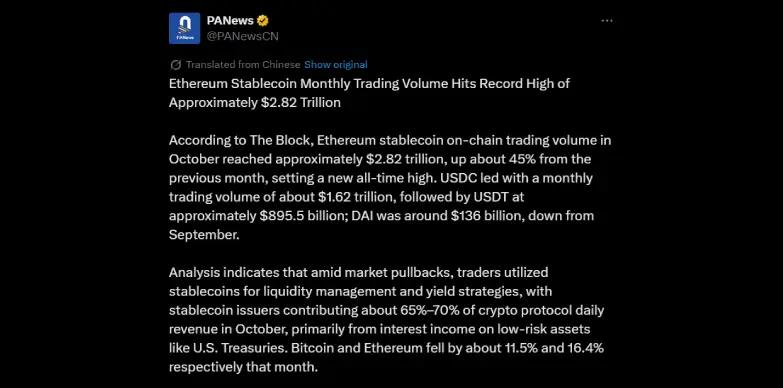Key Highlights:
- Ethereum’s stablecoin trading has surged by 45% in the month of October 2025.
- USDC leads the chart, which is followed by USDT and DAI.
- This surge indicates that the investors are focusing on liquidity and capital preservation more rather than speculations.
Ethereum-based stablecoin activity surged to a great height in October 2025, even though the market has been greatly affected by the recent downturn. The growth of stablecoin activity indicates growing on-chain demand for capital efficiency and conservative yield management during volatile conditions.
Ethereum’s total stablecoin trading volume has reached $2.82 trillion in October. This indicates a 45% jump from September’s figures. The spike comes even as the overall cryptocurrency market has plummeted by 3.51% in the last 24 hours as per CoinMarketCap. This number indicates that the investors are rotating their money into the stable asset space as volatility in the crypto space increases

USDC Leads, USDT and DAI Follow
Among Ethereum’s top stablecoins, Circle’s USDC has come out as the dominant force and has recorded approximately $1.62 trillion in trading volume for October. Tether’s USDT followed at around $895.5 billion, while MakerDAI’s decentralized DAI posted $136 billion, which is slightly down from its September level.
Analysts attribute the divergence to shifting liquidity preferences among traders and institutional players. USDC’s tighter U.S. regulatory footprint and integration across major DeFi protocols have reinforced its perception as a preferred stablecoins for liquidity management and short-term settlement.
On the contrary, USDT’s volume growth remains consistent across high-frequency trading and offshore exchange activity, while DAI’s modest decline aligns with a reduction in leveraged DeFi strategies.
Stablecoin Drive Protocol Revenues
This data also indicates that stablecoins are now a major part of Ethereum’s on-chain economy. Research indicates that stablecoin companies generated around 65 to 70% of daily revenue for crypto protocols in October. Most of this revenue came from interest earned on safe investments like U.S. Treasuries, which have become more profitable because interest rates are still high.
For investors, stablecoins now act like dual-purpose assets as they not only act digital versions of fiat money, but they also reliable income sources within blockchain networks. As more stablecoins offer yield, issuers now have steady business models fuelled by Treasury returns instead of just trading activity.
Market Context: Bitcoin and Ethereum
Amid this surge in stablecoin usage, most of the cryptocurrencies are experiencing a significant decline. The entire crypto market is down by 3.51% as per CoinMarketCap. As of now, Bitcoin is down by 2.69% in the last 24-hours and has hit the $107,000 mark. Ethereum slipped by 4.25% in the last 24-hours and is hovering around the $3,700 mark .
The month of October which is also referred to as Uptober because the prices of cryptocurrencies usually rise during this month. However, this year, this trend was not observed, and the crypto market saw significant decline during this month. This drop drove investors to rebalance into stablecoins, indicating a preference for capital preservation and risk-adjusted participation in yield markets. In the last 30 days, Bitcoin has plummeted by 12.59% and Ethereum has gone down by 18.17% as per CoinMarketCap.
As of today, the psychological environment has also shifted sharply. The crypto Fear and Greed Index is hovering around 36, which indicates a mild fear, while the average crypto Relative Strength Index (RSI) stood at 37.57, indicating an oversold condition.

Implications for DeFi and Institutional Adoption
The surge in trading volume shows that the Ethereum blockchain still leads as the main network for stablecoin transfers, settlements and DeFi activity. Even though newer Layer-2 chains and blockchains such as Solana and Tron are making their presence felt, Ethereum’s large liquidity pool and strong app ecosystem keep it as the preferred place for stablecoin use.
Higher on-chain stablecoin activity may also point towards more participation from institutions as well. With asset managers launching tokenized Treasury and money market products, stablecoins can act as a bridge that links crypto markets with traditional financial systems. This trend boosts Ethereum’s role as the key platform for tokenized dollars, especially as U.S. and global regulators move toward clearer rules for payment stablecoins.
Also Read: STBL Commences $1M Buyback in USDC to Boost Token Value



